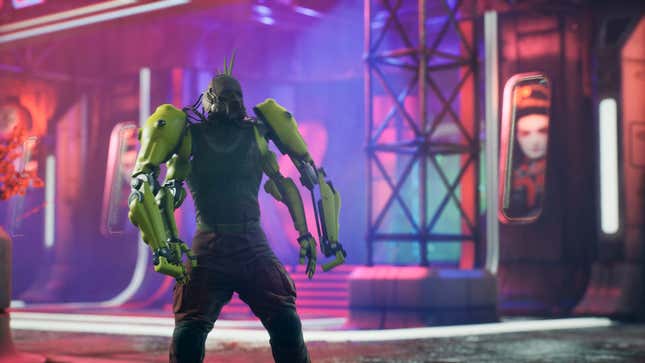
The Ascent is a straight twin-stick shooter for the most part, but there’s a huge difference between surviving and thriving in Veles.
Neon Giant’s debut game is pretty straightforward in terms of controls, but there are a few systems and swings in difficulty that players should be aware of. Fortunately, there are lots of tools and tricks available to help you wipe Veles clean of anything standing in your way — provided you’re well equipped first.
Hand in your bounties — once you have a stack of them
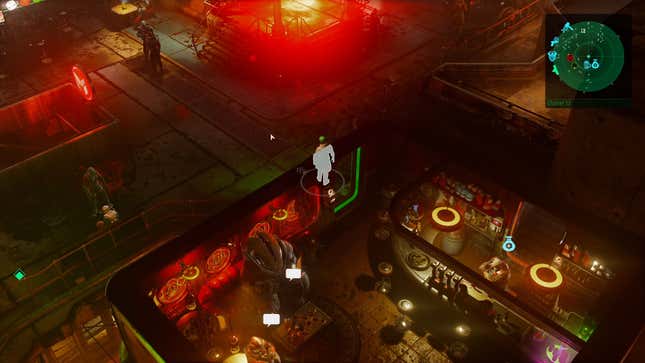
As you play The Ascent you’ll run into little mini-bosses — characters with a specific name and a larger HP bar over their head. These are effectively bounties you can hand in for cash, although you’ll only get the extra cash when you hand the bounty into a bartender. To find a bartender, simply look for the money bag symbol with a plus on it. You’ll see what that looks like above, and the icon will also appear on the mini-map in the top right. Don’t feel obliged to rush to hand in a bounty though: you’re only getting 1,000 uCreds a piece, so it’s not worth visiting the bar until you’ve got several to hand in.
Speaking of cash…
Don’t forget to sell all your duplicate items
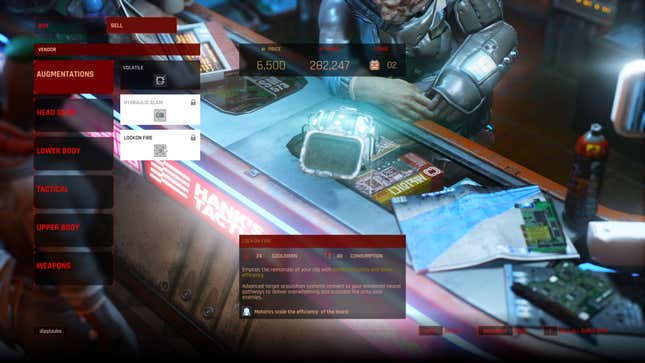
Any time you go to a vendor you’ll be able to sell all of your duplicate weapons, armour, tactical grenades and augmentations. The Ascent doesn’t make this as easy as it could be — you have to go into every category to sell all of your duplicates — but this is easily the fastest way you’ll gain a ton of cash. You can then use those dollars to pick up a specific gun or piece of equipment if you don’t have it.
Double-check your weapon’s damage type, and make sure you equip something with fire damage early.

The most important element in The Ascent‘s weapons isn’t necessarily the DPS value, fire rate or how that all plugs into your stats. It’s actually the type of damage each weapon does, and every weapon will do one of four types of damage.
If you’re struggling in battles, it’s almost 1000 percent because you’ve got the wrong gun/damage type equipped. To make the early battles much easier, make sure you equip a fire-type weapon, specifically the HCF Heat. Even if it’s a lower-level version than some of your other weapons, all humanoid creatures take massive damage from fire —even if those enemies are a much higher level than you.
Similarly, the game will pit you against robots later on. Equipping an energy handcannon or burst rifle is almost mandatory here, especially if you want to quickly deal with the robotspider boss.
Make sure you have enough tier 1 or tier 2 components for upgrades.
As you can see in the shot above — although the UI isn’t as clear as it could be — weapons are upgraded using the components you find throughout the game. But guns can only be upgraded in order. So to take a gun from Mk4 to Mk5 requires 5 tier 1 components — and from Mk5 onwards, you can only use tier 2 components to upgrade that weapon. You can’t use high-tier components to upgrade something stuck at Mk1, so budget accordingly.
Always keep an eye on the red explosive barrels.
Just as the world is filled with seats, barricades and various pillars to hide behind, there’s also plenty of explosive barrels to do your dirty work. This shot from one of the game’s boss fights is a good example. The Siege Mech’s attack radius and AI will draw it around the pillar, and all it takes is a single shot — plus a dodge — to do enormous damage.
But there are tons of opportunities for this in almost any firefight, and you can often draw the AI into the barrel’s range by crouching and dodging around the many bits of cover available.
Remember that almost anything can be cover.
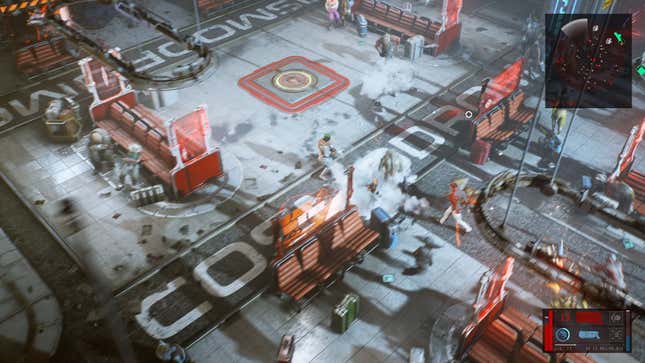
The Ascent is designed to give you lots of opportunities to safely shoot enemies. The above firefight in a public transport area is a great example. You can see several targets on the mini-map, mixed among a ton of civilians who are starting to scatter at the sound of gunfire.
It’s difficult to quickly identify in a crowd all the targets, so the safest thing to do is to pick a corner or a bench. By holding down the aim button, you can shoot targets out in the open, and you’ll be protected from any gunfire. You’ll still have to run from enemies throwing grenades, but using the available space helps you minimise the amount of fights you have to take at any one time.
This ambush in a city street is another good example. It’s not feasible to continue dashing forward, but you can see several opportunities for cover as my character retreats: pillars on the edge or small barriers in the middle of the street. By crouching and circling around those blocks, you can easily protect yourself while picking off enemies at will.
Pay attention to which enemies are rushing you.
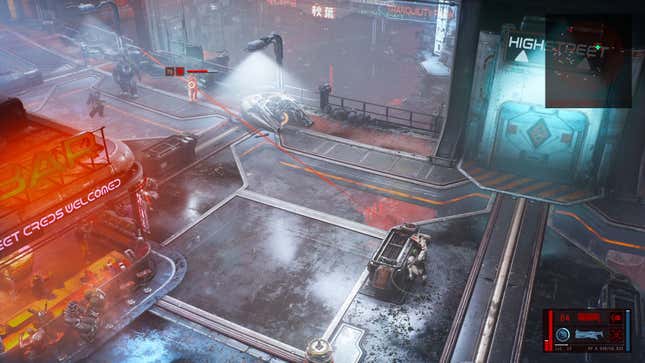
Enemy behaviours are fixed, which is hugely helpful for mentally mapping out battles in advance. In practice, what that means is that you can focus your attacks on which enemies will force you to change your position (either through melee attacks, grenades or other AOE effects).
The above shot is a good example. I’m targeting the enemy to the right here, although the larger foe in the middle is a hammer-wielding character that can do attacks through cover. Their HP is much higher, however, and the skull icon indicates that I can’t withstand too many attacks if I get caught out in the open. So the sensible option here is to pick off the standard ranged enemy from cover, and then I can retreat backwards to deal with the melee enemy as necessary.
It’s also good to use augmentations to exploit AI behaviour. Some of the lower level foes will swarm you, which is a great opportunity for maximising the damage of your grenades. Another option is the augmentation that ‘marks’ enemies, causing them to do explosive AOE damage on death. It’s especially helpful in boss fights too, as the mobs that spawn often are a bigger threat (either directly or because they force you to move into more vulnerable locations).
You can even use this AI behaviour to funnel enemies into tight corridors or doorways. Once an enemy starts rushing, they will always rush your position — while other characters will default to their predefined behaviours. Take advantage of that, and you’ll find most fights become a lot simpler.
Dump a ton of points into aim; don’t spend so much on critical hit or evasion.
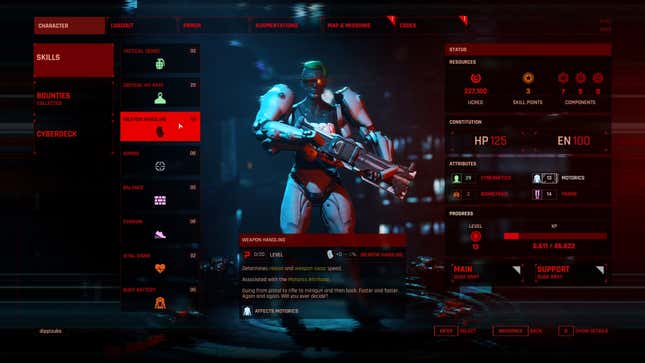
You get three skill points per level, although there’s some bonus skill points scattered throughout Veles. But the most important thing to know is which stats will immediately give you the most return, and which ones don’t.
I’d recommend not dumping a ton of points into your critical hit: it makes out at 20 percent, which is a pretty poor return given the rate of increase you get from the other stats. Aiming, on the other hand, is immensely useful under all scenarios. It reduces the weapon spread recovery rate for all weapons, which you can see on-screen as the aim cursor shrinks and expands after every shot:
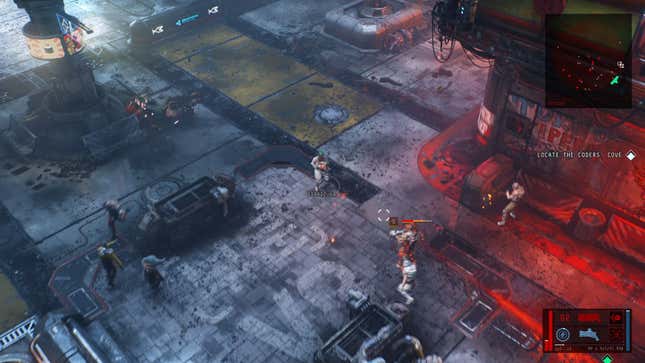
Reducing the weapon spread is a huge deal for burst rifles, shotguns and fully automatic rifles: it means you’ll waste fewer bullets clearing out enemies, especially if you’re trying to pick people off at range. If you want to run around one or two-shotting enemies with the handcannons or pistols, maxing out aim is almost mandatory. Both those weapon types can do a ton of damage, but only if their bullets aren’t being wasted — and when you have a ton of enemies rushing you at once, you can’t afford to have shots flying off target.
Some equipment will buff your core attributes as well, so you don’t need to overinvest in something like health. I’ve made my case for dumping points into aim, but I also think investing a ton into weapon handling — which improves your reload speed — is super essential too. If you want to spend more time using your augments, consider maxing out your tactical sense instead.
Evasion’s also another stat that doesn’t seem super helpful: it doesn’t improve how quickly you can dodge, or its range. So given the base dodge is already pretty quick and gives you enough room to avoid most attacks, you’re better off dropping points into the other stats first.
Set aim assist to medium or high.
This is a formal recommendation from the developers, and it’s one I’d echo. The way aiming works in The Ascent is that you’re targeting an exact spot. So if you aim behind an enemy, don’t expect the bullet will carry through them: you want to be aiming just in front, or precisely on your preferred target. That can be hard to do when you’re getting rushed, particularly on a controller, so don’t feel bad about bumping the assist up.
Some enemies will drop little healing beacons: those will heal you too.
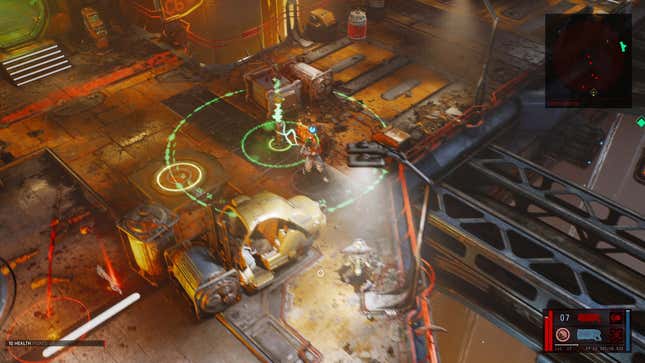
There’s a lot to keep track of in a firefight, but pay attention to the green AOE elements. They’re basically healing beacons that the enemy drops for themselves, but you can take advantage of them as well.
Keep an eye on the ATMs too — they’ll often drop small or large health packs you can use.
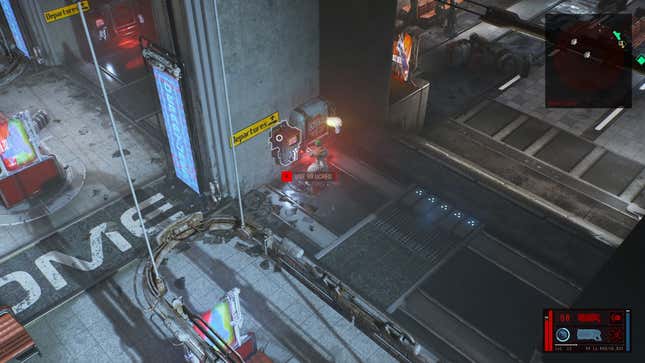
There’s basically three types of ATMs you’ll encounter, and all of them have a small marker on your mini-map. The most expensive ones cost over 100 uCred a pop, and will spit out 50 HP packs. The cheapest ones spit out small health packs, and the 99 uCred one seen above will give you energy potions, which helps refuel your abilities/grenades.
Double-check what buffs you’re getting from your equipment, especially its core attributes.
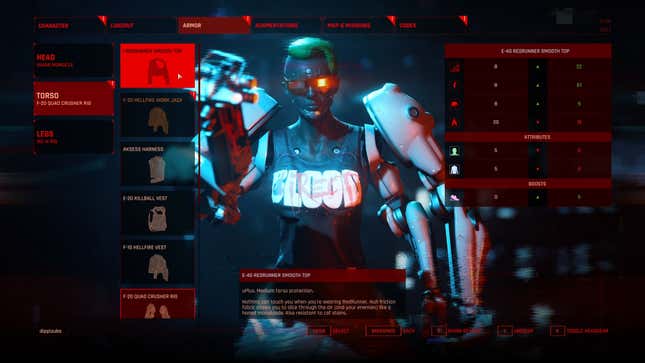
On the right-hand side every piece of equipment will be broken into three categories: a defense rating, attributes and “boosts”. The damage stats basically indicate that, in this case, the Redrunner Smooth Top provides more protection against energy weapons. It’ll also buff my evasion skill by 5 points — which is a healthy boost, but not that practical if you’re not investing points into that stat.
This is worth remembering because you want to swap your armour out to match the enemies you’re fighting, particularly before major boss fights. It’s also handy if you just want to have a top or pants to boost a stat by a little bit — like your health — so you can focus your skill points elsewhere. That said, The Ascent is pretty free with money, so if you need to visit the grafter to reset your skills, you’ll usually be able to afford it.
Note the cross-play isn’t with the Steam version of the game.
If you’re looking to play across PC and Xbox, good news: The Ascent supports cross-play. But it’s only with the UWP version of the game that you’ll get through the Windows Store, or the Xbox Game Pass app, not the build on Steam. Keep that in mind if you’re thinking of playing with friends — although given The Ascent is on Game Pass for PC, as well as console, this isn’t the biggest issue.